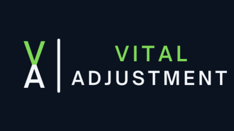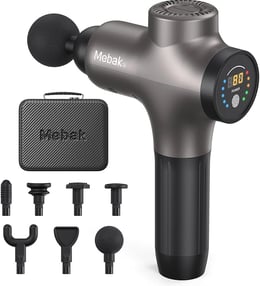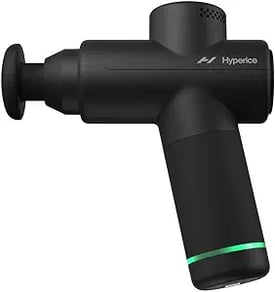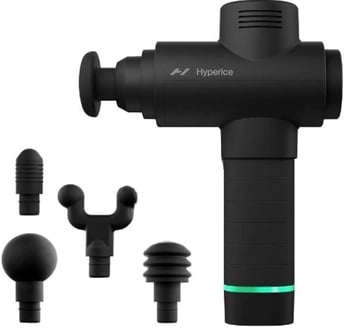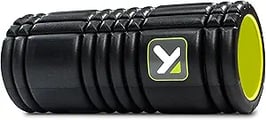Best Massage Guns and Massage Tools for Beginners
Discover the top beginner-friendly massage guns and tools to relieve muscle tension, improve recovery, and feel your best — even if you're just starting out. Affiliate Disclosure: the links in this post are affiliate links. If you decide to purchase a product we recommend, we receive a small commission at no extra cost to you. We only recommend products we use and trust!
RECOVERY
6/2/20257 min read


Your Muscles Are Screaming for Help— But the Right Recovery Tool Could Be the Game-Changer You Need
Ever finished a workout and felt like you got hit by a truck the next day? We've all been there. According to a 2024 study by the American College of Sports Medicine, over 60% of fitness beginners quit within three months due to soreness and burnout. But here's what most people don't realize — that crushing soreness is largely preventable.
Recovery tools like massage guns, foam rollers, and compression devices aren't just for elite athletes anymore. They're game-changers for regular people trying to stay active, feel better, and actually enjoy movement instead of dreading tomorrow's stiffness.
I used to think recovery tools were overpriced gadgets for gym fanatics. After using one to help patients in my clinic, I saw firsthand how effective these tools could be. I didn't think I needed them for my own muscle soreness from my workout routine. It wasn't until I started using the same tools I recommended to my patients — consistently, at home — that I realized what I'd been missing. Recovery transformed from something I prescribed to others into the foundation of my own sustainable fitness routine. It was no longer about simply getting out of pain, but it became a way to prevent pain once I started taking my recovery seriously.
In this guide, I'll walk you through the best beginner-friendly massage guns and recovery tools that deliver real results without breaking the bank. You'll learn what features actually matter, which tools are worth your money, and how to build a simple recovery routine that fits into your life. Let's help your body feel better, recover faster, and keep you moving forward.
Why Recovery Tools Matter (Especially for Beginners)
When you're new to fitness or ramping up activity levels, your muscles experience unfamiliar stress. Without proper recovery, this leads to excessive soreness, fatigue, and often — complete burnout within weeks.
Recovery tools work by:
Improving blood circulation to flush out metabolic waste products
Reducing muscle tension and trigger points that cause pain
Decreasing delayed-onset muscle soreness (DOMS) by up to 30%, according to research
Enhancing flexibility and range of motion
Building body awareness so you can identify and address problem areas early
Here's the counterintuitive truth: beginners often need recovery tools more than seasoned athletes. When you're less conditioned, your body experiences greater stress from the same activities. A 20-minute walk might leave a beginner's calves tight, while an experienced person barely notices.
The mistake I made early on was thinking, "I don't need recovery tools, because I use to do these same activities when I was in high school and I'm stronger now " Wrong. The less adapted your body is, the more it benefits from systematic recovery. I learned this the hard way after three weeks of barely being able to walk downstairs after my "beginner-friendly" workout routine.
How to Choose the Right Tool for You
Consider Your Primary Pain Points
Legs and glutes: Massage gun or foam roller
Back and shoulders: Massage gun with extended handle or massage ball
Feet and calves: Massage ball or compression tools
Full body: Start with a versatile massage gun
Factor in Your Lifestyle
Always on the go: Compact massage gun (Theragun Mini)
Home-focused: Full-size foam roller and massage gun combo
Travel frequently: Portable massage ball and compression socks
Limited storage: Multi-purpose tools like massage guns with various attachments
Set a Realistic Budget
Under $50: Foam roller + massage ball combo
$50-150: Quality foam roller + entry-level massage gun
$150-250: Premium massage gun + accessories
$250+: Professional-grade setup with multiple tools
Now that you understand what to look for, here are my top recommendations based on these criteria:
Top Massage Guns for Beginners
1. Mebak 3 Massage Gun (Best for Beginners on a Budget)
Price: $99
Why it's perfect for beginners: Portable, simple one-button operation, and powerful enough to be effective without being overwhelming. Plus its the same one I started with 5 years ago and still am using today as my at home device!
Key Features:
3-6 hours of battery life
Surprisingly quiet operation
Five speed settings
Comes with seven attachments for a wide range of use scenarios
Comes with a nice carrying case to keep everything in one place
Best for: People who want professional-grade results in a beginner-friendly package. The Mebak 3 proves you don't need a $400 device to get results.
2. Hypeice Hypervolt Go 2 (Most Portable)
Price: $139
Why beginners love it: Lightweight, intuitive design, and gentle enough for sensitive muscles while still being effective.
Key Features:
40% lighter than the original Hypervolt at only 1.5lbs
Three speeds with LED indicators
Quiet Glide technology
Three-hour battery life
Two attachment heads included
Best for: People who are on the go and need something small to pack easily the without premium pricing.
3. Hyperice Hypervolt 2(Best Overall)
Price: $229
Why beginners love it: Sleek, quiet, and built for recovery without being overwhelming. The Hypervolt 2 offers premium quality with a user-friendly design that’s easy to pick up and start using — no experience needed. This is also the same one we use in the clinic daily on our patients.
Key Features:
Three speeds powered by a high-torque 60W motor
Patented QuietGlide® technology for whisper-quiet sessions
Bluetooth® connectivity for guided routines via the Hyperice App
Up to 3 hours of battery life per charge
Comes with 5 interchangeable head attachments and a carrying case for them.
Best for: Beginners and fitness enthusiasts who want a high-end recovery tool that’s portable, quiet, and delivers pro-level results at home — with minimal setup and maximum performance. This device is quite, smooth, and delivers an awesome experience.
Essential Massage Tools Beyond Guns
Foam Roller
TRIGGERPOINT Performance Therapy Grid Foam Roller ($40) The gold standard for beginners. The textured surface provides the right amount of pressure without being torture. Start with 30-second intervals on each muscle group.
If there is one tool I use as much or more than my massage gun is my foam roller. They are great for improving mobility, reducing muscle tension, and speeding up recovery. They work by applying pressure to tight areas (trigger points), helping to release muscle knots, increase blood flow, and improve range of motion.
Massage Ball
Lacrosse Ball ($3-5) The ultimate bang-for-your-buck tool. Use against walls for back trigger points or under your foot for plantar fascia relief.
Lacrosse balls are a powerful tool for targeting deep muscle knots that foam rollers can’t quite reach. While foam rollers work well for large muscle groups, lacrosse balls allow for pinpoint precision — perfect for breaking up tight spots in areas like the shoulders, glutes, feet, and hips. Their firmness and size make them ideal for trigger point therapy, helping to release tension, restore mobility, and speed up recovery with just a few minutes of use.
Building Your Beginner Recovery Routine
30 seconds per major muscle group with your chosen tool
Focus on areas you'll use that day (legs before a run, shoulders before upper body work)
Hit problem spots immediately after workouts while muscles are warm
The 15-Minute Deep Session (2-3x per week)
Start with larger muscle groups (quads, hamstrings, back)
Work systematically from top to bottom or bottom to top
Spend 1-2 minutes per area
End with gentle stretching
The Recovery Day Routine (once weekly)
20-30 minutes of comprehensive tool use
Target every major muscle group
Include mobility work and light stretching
Follow with hydration and rest
Common Beginner Mistakes to Avoid
Going Too Hard, Too Fast
I thought "more pressure equals better results." Wrong. You can actually cause more tension by being too aggressive. Start gentle and gradually increase intensity. The Mebak 3 and Hypervolt 2 offer pressure sensing technology to show you if your pressing too hard.
Skipping Consistency for Intensity
Using tools once a week intensively is less effective than five-ten minutes daily. Recovery is about habit, not heroics.
Buying Every Tool at Once
Start with one versatile tool, learn to use it well, then add others based on what you actually need.
Ignoring Proper Technique
Spend five minutes watching tutorial videos. Poor technique can make tools ineffective or even harmful leading to increased soreness or pain. You should not see bruising when your done.
Budget-Friendly Alternatives and DIY Options
Tennis Ball Magic
A $3 tennis ball can replicate 80% of what expensive massage balls do. Use it against walls for back work or under your feet.
Frozen Water Bottle Roller
Fill a water bottle, freeze it, and roll it under your feet for plantar fasciitis relief. The cold reduces inflammation while the pressure works trigger points.
Towel Stretching
A simple towel can help with hamstring stretches and shoulder mobility work when tools aren't available.
When to Seek Professional Help
Recovery tools are amazing, but they're not magic. See a healthcare provider if you experience:
Pain that worsens with tool use
Persistent pain lasting more than a week
Numbness or tingling
Pain that interferes with daily activities
Think of recovery tools as maintenance, not medical treatment. They keep your body running smoothly but can't fix underlying injuries or structural issues.
Recovery Isn’t Optional — It’s the Secret Weapon to Staying Consistent
Recovery doesn't have to be complicated or expensive to be effective. Whether you start with a $5 lacrosse ball or invest in a premium massage gun, the key is consistency and proper technique.
Your body adapts to new movement patterns and stress, but it needs help along the way. The right recovery tools, used regularly, can be the difference between sustainable progress and another abandoned fitness journey.
Start small, stay consistent, and listen to your body. Your future self — the one who can actually enjoy being active instead of dreading the next day's soreness — will thank you.
Remember: the best recovery tool is the one you'll actually use. Choose something that fits your lifestyle, budget, and preferences, then make it part of your routine. Your journey to feeling better starts with that first five-minute session.
Ready to get started? Pick one tool from this guide, commit to using it for two weeks, and experience the difference proper recovery can make in your fitness journey.
Vital Adjustment
Disclaimer
Vital Adjustment is not a healthcare facility. No doctor -patient relationship is formed as a result of using our website, resources or templates. All information is strictly for information and educational purposes only. If you need specific healthcare advice, you should contact your primary care.
NEWSLETTER
© 2025. All rights reserved.
Click here to be redirected to our newsletter Vital Wellness Weekly. Where we dive deeper on topics we discus in our blog and podcast.
